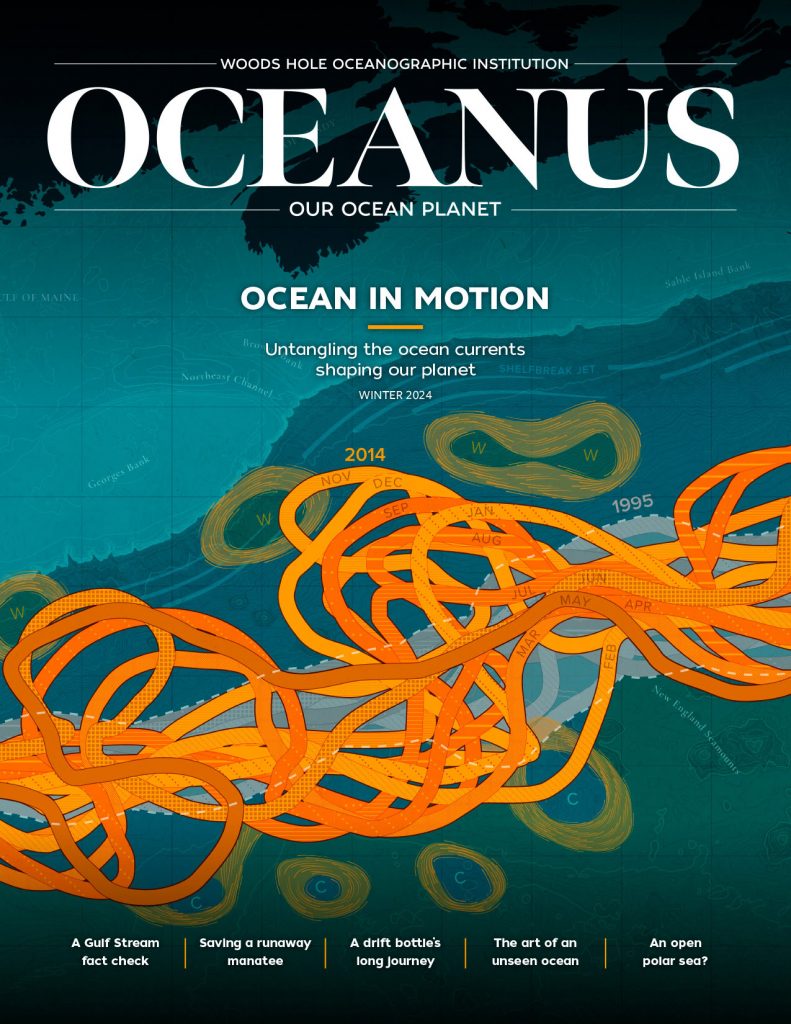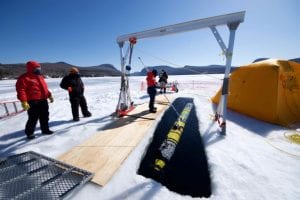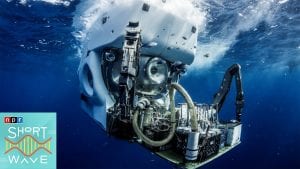Underwater Vehicles
Robot Dives 3,000 Feet to Film Creatures in Mid-Ocean ‘Twilight Zone’
Bioluminescent creatures and others inhabiting the dark depths 3,000 feet below the surface in the mid-ocean “twilight zone” — beyond the reach of sunlight — are now being documented by a research robot called Mesobot. The underwater robot was created in a joint effort by the Woods Hole Oceanographic Institution, the Monterey Bay Aquarium Research Institute and Stanford University.
Alvin: Pioneer of the Deep
The deep-sea submersible Alvin has brought explorers to extraordinary places for more than 50 years. Now, as Alvin is poised to continue its revolutionary scientific work, a new set of upgrades will take it deeper than ever before. A coproduction with the Woods Hole Oceanographic Institution.
Roaming the Depths: The Role of Autonomous Assets in the EXPORTS Campaign
The difficulty of science at sea has been one driving factor in the development of autonomous platforms for use in scientific research.
A Robot Like This Could Swim At Jupiter’s Water-Spewing Moon
A NASA mission called Europa Clipper may, if funding and development timelines hold, launch in 2024 to do an orbital survey with the latest instruments and potentially, to pick some landing spots for a future spacecraft. And unlike the rovers we are used to on Mars, this futuristic robot is going to have to swim.
NASA Teams up with Deep-Sea Explorers to prep for Europa Missions and Beyond
Weighing about 550 pounds, the six-foot-long Orpheus drone cost nearly $2 million to build and was named for the Greek poet and prophet. The main goal for this next-generation mini-submarine that was engineered and constructed by WHOI in Massachusetts, will be to increase our knowledge of the deepest areas of our planet’s oceans known as the hadal zone.
Arctic AUV Listens Its Way Forward with New Navigation Method
To successfully navigate throughout the Arctic requires understanding how these changes in sound propagation affect a vehicle’s ability to communicate and navigate.
Navigating beneath the Arctic ice
A team of MIT engineers has developed a navigational method for autonomous vehicles to navigate accurately in the Arctic Ocean without GPS.
New Underwater Vehicle Gets First Tryout
Long-range autonomous underwater vehicles are being engineered to help with natural disaster response.
Alvin Pilot Is Guest Speaker For Supper Club Series
Arctic scientists test underwater drone on Willoughby Lake
New England winters can often feel as cold as the Arctic. But for researchers from WHOI’s Applied Ocean Physics & Engineering department, Vermont’s polar-like cold proved to be the perfect testing site for Remus 600. The state’s deepest lake – Lake Willoughby – offered fewer risks than the Arctic Ocean, while providing important data about ice measurement and water temperature, helping to streamline the real mission this fall.
A Quick Dive Into How Submarines Work
Submarines can descend thousands of feet below the surface of the ocean, but to do so, they have to deal with an enormous amount of pressure. NPR caught up with WHOI’s Bruce Strickrott, Group Manager and Chief Pilot of the Deep Submergence Vehicle Alvin, who explains some of the fundamental engineering principles that allow submarines to dive so deep without imploding under the pressure, and shares updates on Alvin’s overhaul and future dives.
Human Occupied Vehicle (HOV) Alvin is part of the National Deep Submergence Facility (NDSF). Alvin is one of the most recognized deep submergence vessels in the world and the only one in the U.S. capable of carrying humans into extreme ocean depths. The sub has completed 5,065 successful dives, more than all other submersible programs worldwide combined. When Alvin relaunches next fall, the iconic sub will have the ability to dive to 6500 meters (21,325 feet)—almost 4 miles deep and 2,000 meters deeper than Alvin’s current maximum depth of 4500 meters (14,800 feet). The upgrade will also give the sub access to 99% of the ocean floor.
Quantum-enabled scanner will boost our understanding of brain function, doing research 6.5 km under the ocean’s surface
Soule talks to Physics World’s James Dacey about doing science in the Alvin submersible vehicle, which is currently be refurbished to allow it to reach the astonishing depth of 6.5 km.
The Water Below
Drawing on 90 years of leadership in ocean discovery and exploration, Woods Hole Oceanographic Institution (WHOI) scientists are engaged in an array of research projects using autonomous systems to advance their understanding of marine environments.
WHOI Reveals Upgrades to Iconic Submersible Alvin
Increased depth range and the ability to explore 99% of the ocean floor, including the abyssal region—one of the least understood areas of the deep sea—are just some of the upgrades underway for the iconic human-occupied Vehicle (HOV) Alvin that were unveiled today at the American Geophysical Union’s (AGU) Fall Meeting 2020.
Sea Ahead
The game-changing technologies that will transform our ability to understand and manage Earth’s last great frontier. Monitoring instruments—and ocean technologies in general—have come a long way. We now have Artificial Intelligence (AI)-enabled robots that not only allow researchers to access the most remote spots in the ocean, but can decide where to explore once they get there.
How the waters off Catalina became a DDT dumping ground …
A scientist involved in the discovery of the Titanic happened to be on board, so he helped them program the robots on where to go and how to search for the barrels. A marine geochemistry lab at WHOI ran the samples.
Is seaweed the future of fuel?
“Macroalgae needs to scale up to the point where it’s economically feasible for biofuel, and to do this we are going to have thousands of hectares of farms,” says Erin Fischell, an assistant scientist at WHOI.
Is seaweed the future of fuel?
Erin Fischell, an assistant scientist at WHOI, points out: “Macroalgae needs to scale up to the point where it’s economically feasible for biofuel, and to do this we are going to have thousands of hectares of farms.”
Decoding The Black Box: The 2015 US Disaster That Revolutionized Ship Crash Investigations
The first challenge for the El Faro was to locate and extract the VDR. It took three expeditions over 11 months and the use of novel video telepresence, to be able to go down, retrieve it. The NTSB and Woods Hole Oceanographic Institution also highlight the lengths they went to here.
A New Ship’s Mission: Let the Deep Sea Be Seen
Mr. Dalio was thinking of buying the Alucia when a team of WHOI experts used the vessel and an undersea robot to find the shattered remains of Air France Flight 447, which in 2009 had vanished over the South Atlantic with 228 passengers. Other search teams had failed, and Mr. Dalio saw the 2011 success as an indication of the field’s exploratory promise.
Why is it important to study life in the deep sea and even below the seafloor?
Dr Virginia Edgcomb heads a laboratory at WHOI in the US. She spent three months on a ship in the middle of the Indian Ocean conducting research as part of a quest to find evidence of microbial life within the lower oceanic crust.
ROVs: A marine robotics paragon.
Carl Wirsen from WHOI, in his presentation, displayed how little we know about the deepest part of the oceans.
Earth’s oceans may hold the key to finding life beyond our planet
The second vehicle is our Orpheus vehicle, and this is a partnership between JPL and the Woods Hole Oceanographic Institution.
Volcano space robots are prepping for a wild mission to Jupiter
To build machines capable of plunging into the frozen oceans on Europa and Enceladus, Nasa tested out submersibles in one of Earth’s most inhospitable environments








